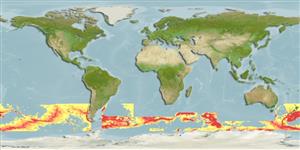Common names from other countries
>
Myctophiformes (Lanternfishes) >
Myctophidae (Lanternfishes) > Gymnoscopelinae
Etymology: Gymnoscopelus: Greek, gymnos = naked + Greek, skopelos, a lantern fish (Ref. 45335).
More on author: Andriashev.
Environment: milieu / climate zone / depth range / distribution range
Ecología
marino bentopelágico; oceanodromo (Ref. 51243); rango de profundidad ? - 4200 m (Ref. 58018). Temperate; 34°S - 67°S, 58°W - 71°W
Generally ranges between Antarctic Polar Front and Subtropical Convergence, but with northern extension to about 38°S off Argentina, to 40°S off Chile and to 34°S in the southeast Atlantic.
Tamaño / Peso / Age
Maturity: Lm ? range ? - ? cm
Max length : 28.0 cm SL macho / no sexado; (Ref. 5182)
Short description
Claves de identificación | Morfología | Morfometría
Espinas dorsales (total) : 0; Radios blandos dorsales (total) : 19 - 22; Espinas anales: 0; Radios blandos anales: 19 - 22.
Oceanic and mesopelagic (Ref. 4066). Found within the upper 200 m in the region of Antarctic Polar Front, but inhabits deeper northwards at night.
Life cycle and mating behavior
Maturities | Reproducción | Spawnings | Egg(s) | Fecundities | Larva
Hulley, P.A., 1990. Myctophidae. p. 146-178. In O. Gon and P.C. Heemstra (eds.) Fishes of the Southern Ocean. J.L.B. Smith Institute of Ichthyology, Grahamstown, South Africa. (Ref. 5182)
IUCN Red List Status (Ref. 130435)
CITES (Ref. 128078)
Not Evaluated
Threat to humans
Harmless
Human uses
Pesquerías: escaso valor comercial
Herramientas
Special reports
Download XML
Fuentes de Internet
Estimates based on models
Preferred temperature (Ref.
115969): 1.5 - 5.6, mean 2.6 (based on 596 cells).
Phylogenetic diversity index (Ref.
82804): PD
50 = 0.5039 [Uniqueness, from 0.5 = low to 2.0 = high].
Bayesian length-weight: a=0.00407 (0.00222 - 0.00749), b=3.23 (3.06 - 3.40), in cm Total Length, based on LWR estimates for this species & (Sub)family-body (Ref.
93245).
Nivel trófico (Ref.
69278): 3.3 ±0.47 se; based on food items.
Resiliencia (Ref.
120179): Bajo, población duplicada en un tiempo mínimo de 4.5-14 años (Preliminary K or Fecundity.).
Fishing Vulnerability (Ref.
59153): Low vulnerability (24 of 100).
